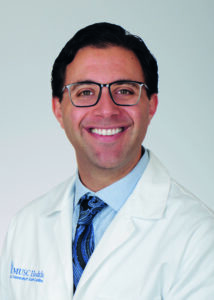
Like any good presentation I feel obligated to start with my disclosures: 1) I am married to a woman who decided to pursue a separate fellowship in bioethics, even after a fellowship in pediatric anesthesia. This means that every time I come home and start to discuss a patient’s tough clinical situation, I am invariably met with the question, “Did you discuss all their options with them?” And, 2) I just celebrated my one-year anniversary of being an attending, and, while my confidence slowly grows with each day, I am still always a bit apprehensive when it comes to any major vascular case, from a carotid endarterectomy to a complex bypass—and particularly open aortic surgery.
Allow me to present Patient X, a 70-year-old male who was transferred to our hospital while I was on call. He presented to an outside hospital with obstipation of several days’ duration with associated abdominal pain. His history was notable for an aortic endograft placed for aneurysm four years prior which was explanted and replaced with a rifampin-soaked interposition graft for infection in the last two years. The outside physicians were concerned mostly about his bowel obstruction but thought something was “off ” about how the bowel was associated with the graft. Like most centers, we accepted the patient to get them to our hospital and figured we would get the necessary teams involved upon arrival. Upon his arrival to our hospital, we got our gastrointestinal surgery colleagues involved and began working through his history and current status. His initial labs showed a severe leukocytosis and within 24 hours his blood cultures were growing pseudomonas. Additionally, within 24 hours of presenting to our hospital, he began to show signs and symptoms of a colovesicular fistula. A nuclear medicine study was done showing definitive uptake at the site of his aortobifemoral bypass.
To summarize, we have a 70-year-old man with a prior infected endovascular aneurysm repair (EVAR) that was explanted and repaired with a rifampin-soaked Dacron graft which was now also infected and causing a bowel obstruction, leading to sepsis, in addition to a colovesicular fistula.
At this point I’d like to introduce the term “end-stage vascular disease” and, with the readers’ permission, apply it to Patient X. I do not make this statement lightly, nor mean anything offensive by it. My wife and I were discussing patients one evening and she made a comment that really stuck with me. She equated vascular surgery to medical oncology in the sense that in the world of medicine, medical oncology patients often have very tough pathology to treat, “wins” are hard to come by, and any intervention, more often than not, alters the future quality of life for the patient in addition to duration. Furthermore, there are patients that present with terminal disease who despite all the best efforts and current medicine/technology available, intervention is unlikely to alter the inevitable outcome.
I consider myself more than fortunate to have trained at some of the best institutions in the country where the above story is only all too common. These patients present to our hospitals as we are usually the only facility in the state/region with the appropriate recourses and supporting personnel capable of handling such complex pathologies. Their understanding of their pathology is understandably limited, and they appreciate the gravity of the situation only as it applies to need for their transfer. As a trainee, I’d get fairly excited about this pathology and the opportunity to undertake a major vascular surgery to cure the patient of their infection that could (and most likely would) result in death in the not-too-distant future. When consenting them and their families for their procedure, we were trained to be as accurate as accountants when it came to risks associated with the specific procedure each patient would need while still being human—talking them through the potential outcomes and try to paint a picture of what life would look like should the patient make it through their procedure.
The next few weeks would proceed in a fairly standard fashion including a complex and lengthy surgery with major blood loss; some form of a post-operative complication; prolonged hospital stay; and a transition to inpatient rehabilitation. While the life of a trainee meant that I was usually on a different service/rotation by the time these patients came back for follow-up, my particular interest in these patients infected aortic pathology made me track their outcomes and, not surprisingly, only about 50% of these patients ever made it back for their follow-up once discharged, with about 25% never making it out of the hospital.
So, 13 months into practice, I am presented with Patient X and it is my job to discuss with him our options on how to proceed, knowing that regardless of his decision, I am about to affect the course of not just his life, but the life of all his friends and family. If I’m being honest, I was torn. Here I am talking to a man who just retired and had grand plans to finally enjoy his well-earned retirement with his wife by traveling and experiencing the world. If I steered him towards surgery, we all know what his life would look like for the next year as well as the associated numbers as stated above. But what was my alternative suggestion? What would my peers and partners think? Would they think I was simply scared to tackle this type of procedure? This would be the biggest case I could have done as junior faculty and I know it is the only “life-sustaining” option? We are taught to offer surgery when the benefits outweigh the risks. The risk of not operating in patients with end-stage vascular disease is most often death. This could be an imminent death, a death within a certain amount of time, or eventual death—but death is the conclusion.
I kept thinking about what Patient X’s life would look like and how he would remember his final days should we proceed with surgery. Then I discussed the case with my wife. Physicians, specifically surgeons, often fall victim to the following sentiment “[doctors] will do everything they can to prolong someone’s life… many medical practitioners are not trained to handle conversations that focus on quality of life or relief of pain and suffering, and instead lean toward recommending their own treatments.” This is a quote from Jeffrey Schnipper, MD, research director for the Division of General Internal Medicine and Primary Care at Brigham and Women’s Hospital, taken from an article about physicians’ lack of understanding regarding end-of-life care. In a study titled “Surgeons’ perceived barriers to palliative and end-of-life care” in the Journal of Palliative Care Medicine from 2018, 76% of surgeon responders cited no formal training or education in palliative care, while more than one-third cited lack of training in how to forgo life-sustaining measures and communication regarding these matters.
What if Patient X’s final days involved a few extra medications to treat symptoms but also family dinners and a trip to an exotic destination he had always wanted? He would ultimately succumb to his infective process, but did that mean not enjoying the time between then and now? Could we offer a picture that focused on enjoying the time he had instead of “fighting” through the proposed surgical course?
I sat down and had a family meeting with Patient X, his wife, his brother and sister-in-law. I drew pictures, explained the proposed procedure(s), potential complications, and expected hospital and post-operative course. I laid out a timeline. I was blunt. I was not callous, but I was direct. I then offered some alternatives (after discussing with our infectious disease, gastrointestinal surgery, and urology colleagues). I offered Patient X the option of antibiotic therapy and pain medication to treat his symptoms. I painted a picture of what his life would look like through this option’s lenses. I then told everyone in the room that Patient X had my support no matter his decision and that we would do everything in our power to ensure the best outcome regardless of his choice. Then I sat there silently.
What felt like an eternity passed. Patient X broke the silence. He started by thanking me. All parties asked several questions to understand the details that were pertinent to them. They asked me what I would do. The question I feared but prepared for. I told them that the answer to that question depends on what each individual values. I couldn’t decide for Patient X what values were most important to him. All I could do is paint as realistic picture as possible and hope that one option would resonate with them. I told them that I know individuals who would happily select either path based on their values and that there is no wrong answer. They thanked me again and asked for some time to decide.
I felt drained. What had I just done? Was I being a coward? My goal is not to talk all of my complex patients out of their complex surgeries. I do feel strongly that we as a society, and surgical community, need to focus more on these types of conversations and goals when interacting with our patients and our trainees. Quality of life is a metric more recently making into the literature, but why is it not a course that all medical students are taught or a rotation that interventional trainees must spend one month to counsel patients appropriately about all their options?
I was paged not too long after the conversation… Patient X wanted to go home on antibiotics and take a trip to a city he and his wife had been looking forward to visiting for many years.
Adam Tanious, MD, is an associate program director for the vascular surgery residency program at the Medical University of South Carolina (MUSC) in Charleston, South Carolina.













Very well written and written with a great perspective.